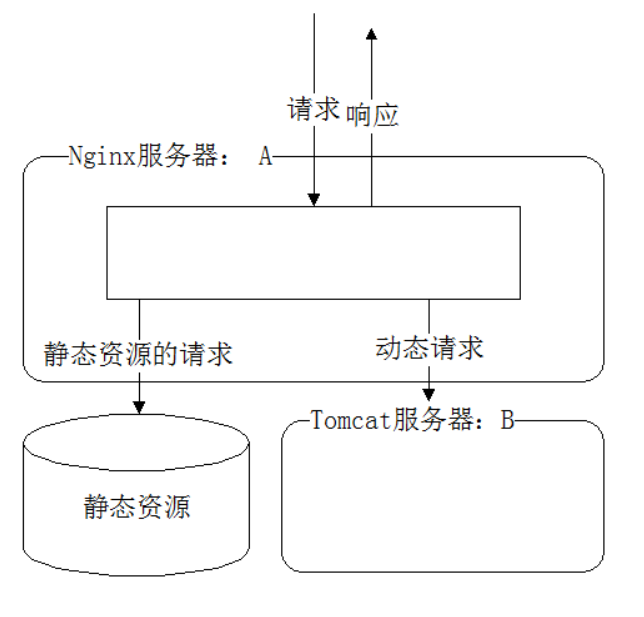Nginx之动静分离
为什么要动静分离呢?
拿Nginx来说,Nginx是Web服务器,仅仅只能处理静态资源(例如js,img,css等等),而Tomcat属于应用服务器既能处理静态资源又能处理动态资源(例如jsp,freemarker,volocity等等)。但是Nginx处理静态资源的效率要高于Tomcat,而Tomcat处理静态资源的效率要低于Nginx很多,术业有专攻是也。由此,我相信大家明白了为什么要动静分离了。
如果还有不明白的,简单的说,web开发的本质就是HTTP请求,将成千上万的请求归类进行分发,谁谁处理这个,谁谁处理那个,取其优势,应用之。这样,毋庸置疑,效率肯定会上去的。
另外说下常用的应用服务器和web服务器?
常用的web服务器:Nginx、Apache等等。
常用的应用服务器:Tomcat、Jboss、Resin、WebLogic等等。
其实Apache也可以做动静分离,只不过我认为Nginx更简单。
关于Nginx的安装可以参考菜鸟教程:http://www.runoob.com/linux/nginx-install-setup.html
关于Nginx的学习和各个模块的含义可以参考这个网址:http://www.nginx.cn/doc/
关于负载均衡和集群均可以参考我的这两篇文章:
nginx反向代理和tomcat集群(适用于ubutnu16.04及其centos7)
1.动静分离架构图

2.Nginx配置
主要修改nginx.conf配置文件
upstream yctech{
server 192.168.126.128:8080;
}
server {
listen 80;
server_name yctech;
#charset koi8-r;
#access_log logs/host.access.log main;
root /test;
location / {
proxy_pass http://yctech;
root html;
index index.html index.htm;
}
location ~ ^/yctech1/(.*){
proxy_set_header Host $host;
proxy_set_header X-Real-IP $remote_addr;
proxy_pass http://yctech; #转向tomcat处理
}
location ~ ^/yctech2/(.*){
proxy_set_header Host $host;
proxy_set_header X-Real-IP $remote_addr;
proxy_pass http://yctech; #转向tomcat处理
}
location ~ ^/yctech3/(.*){
proxy_set_header Host $host;
proxy_set_header X-Real-IP $remote_addr;
proxy_pass http://yctech; #转向tomcat处理
}
location ~ ^/yctech4/(.*){
proxy_set_header Host $host;
proxy_set_header X-Real-IP $remote_addr;
proxy_pass http://yctech; #转向tomcat处理
}
location ~ .*\.(gif|jpg|jpeg|png|bmp|swf|css)$ {
expires 30d;
}
root 对应的html是nginx的一个目录,这个目录下通常是官网的主页。
像root /test;
是因为html下有test目录,而test目录主要放置静态资源,同时也是处理静态资源。

3.编写index.jsp页面测试
<%@ page language="java" contentType="text/html; charset=UTF-8" pageEncoding="UTF-8"%> <!DOCTYPE html PUBLIC "-//W3C//DTD HTML 4.01 Transitional//EN" "http://www.w3.org/TR/html4/loose.dtd"> <html> <head> <meta http-equiv="Content-Type" content="text/html; charset=ISO-8859-1"> <title>Insert title here</title> </head> <body> <img src="logo_small.png" width="500px" height="500px"/> </body> </html>
jsp页面中的logo_small.png其实是放在test目录下的。
4.重启Nginx
./sbin/nginx -s reload 并在浏览器上输入对应的地址,即可看到对应的效果。
参考思路博文为:https://www.cnblogs.com/xiaoblog/p/4241086.html





【推荐】国内首个AI IDE,深度理解中文开发场景,立即下载体验Trae
【推荐】编程新体验,更懂你的AI,立即体验豆包MarsCode编程助手
【推荐】抖音旗下AI助手豆包,你的智能百科全书,全免费不限次数
【推荐】轻量又高性能的 SSH 工具 IShell:AI 加持,快人一步
· 如何编写易于单元测试的代码
· 10年+ .NET Coder 心语,封装的思维:从隐藏、稳定开始理解其本质意义
· .NET Core 中如何实现缓存的预热?
· 从 HTTP 原因短语缺失研究 HTTP/2 和 HTTP/3 的设计差异
· AI与.NET技术实操系列:向量存储与相似性搜索在 .NET 中的实现
· 周边上新:园子的第一款马克杯温暖上架
· Open-Sora 2.0 重磅开源!
· 分享 3 个 .NET 开源的文件压缩处理库,助力快速实现文件压缩解压功能!
· Ollama——大语言模型本地部署的极速利器
· [AI/GPT/综述] AI Agent的设计模式综述